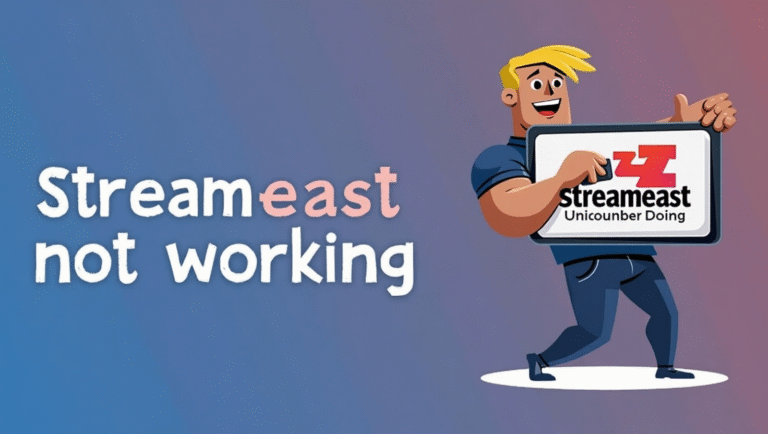Introduction
On August 17, 2024, U.S. authorities, led by Homeland Security Investigations (HSI), Seized Streameast domains, accusing the site of copyright infringement. This action disrupted access for millions of users and sparked debates about piracy, accessibility, and the future of sports streaming. While the seizure aimed to protect intellectual property, it also highlighted the challenges of balancing consumer demand with legal enforcement. In today’s digital world, watching live sports has become easier than ever, thanks to streaming platforms. However, not everyone can afford pricey subscriptions to services like ESPN+ or NBC Sports. As a result, many fans turn to free, often illegal, streaming sites. Streameast was one such platform, wildly popular for offering free live streams of sports like football, basketball, and soccer.
What Was Streameast?
Streameast was a go-to platform for sports fans seeking free access to live games. Launched several years ago, it offered streams for a wide range of sports, including American football, soccer, basketball, combat sports, baseball, and hockey. Its simple, user-friendly interface made it easy for anyone to find and watch their favorite events. With over 15 million monthly visitors, Streameast rivaled some legal streaming services in popularity. Fans loved it for bypassing expensive paywalls, especially in regions where legal options were limited. Due to disagreements between Altitude TV and cable companies like Comcast, Denver fans watched Nuggets and Avalanche games on Streameast. Even high-profile figures, like LeBron James, reportedly used the site, boosting its fame. However, its success came at a cost, as it operated in a legal gray area, distributing copyrighted content without permission.
The Seizure: A Legal Crackdown
On August 17, 2024, Homeland Security Investigations (HSI) seized several Streameast domains, including thestreameast.to, streameast.io, and streameast.xyz. Visitors to these sites were met with a stark message: “This domain name has been seized by Homeland Security Investigations (HSI) pursuant to a warrant issued by the United States District Court for the Eastern District of Louisiana under the authority of, inter alia, Title 18, United States Code, Section 2323.” This law targets criminal copyright infringement, with penalties including fines and imprisonment. The seizure was part of a broader U.S. effort to combat sports streaming piracy, which costs rights holders millions in revenue. Authorities accused Streameast of illegally distributing copyrighted material, such as live sports broadcasts. The action sent a clear message: piracy, even if popular, faces serious consequences. Yet, the effectiveness of such measures remains uncertain, as pirate sites often adapt quickly.
Impact on Sports Fans
The seizure hit sports fans hard, especially those who relied on Streameast to watch games without paying for subscriptions. For many, the platform was a lifeline, offering access to events that were otherwise behind expensive paywalls or unavailable due to regional restrictions. In Denver, for instance, fans of the Nuggets and Avalanche turned to Streameast because of ongoing disputes between Altitude TV and providers like Comcast and DISH. Social media buzzed with frustration as users scrambled to find alternatives. Some shared links to other pirate sites, while others expressed disappointment over losing a reliable service. The seizure highlighted a broader issue: the high cost of legal streaming services can push fans toward illegal options. While authorities aim to protect intellectual property, the immediate impact was felt by everyday fans who now faced limited access to their favorite sports.
Streameast’s Defiant Response
Despite the seizure, Streameast’s operators didn’t back down. Within days, the site was back online using alternative domains, showcasing their resilience. In a bold statement on social media, they claimed, “Our streams will never go offline. We have more decoy streams than you could imagine. We have self-replicating private servers in storage. We have more domains than Apple and Google combined.” This defiance underscores the challenges of shutting down pirate operations.In addition, Streameast announced its intention to file a legal appeal against the seizure, arguing that it was unlawful. This legal battle could set precedents for how copyright cases are handled in the digital age. For now, the operators’ quick recovery suggests that domain seizures, while disruptive, may not be enough to stop determined pirate sites. Their ability to adapt keeps Streameast alive, at least for the moment.
Legal and Ethical Implications
The Streameast seizure raises complex legal and ethical questions. Legally, it reflects the U.S. government’s commitment to protecting intellectual property. Copyright holders, like sports leagues and broadcasters, lose significant revenue when platforms like Streameast offer free streams. The legal basis for the seizure, Title 18, Section 2323, allows for strong penalties, signaling that authorities take piracy seriously. However, ethically, the issue is less clear-cut. Many fans argue that high subscription costs for legal streaming services make platforms like Streameast a necessity, especially for those who can’t afford multiple subscriptions. This creates a moral dilemma: should access to sports be a luxury, or is it acceptable to seek free alternatives, even if illegal? Moreover, domain seizures may only be a temporary fix, as pirate sites often resurface. This ongoing cat-and-mouse game suggests that broader solutions, like affordable legal options, might be needed to address the root causes of piracy.
The Future of Sports Streaming
The Streameast seizure points to a turbulent future for sports streaming. As piracy becomes harder to control, legal streaming services face pressure to adapt. Offering more affordable subscriptions or ad-supported models could reduce the appeal of pirate sites. Meanwhile, authorities may explore new strategies, such as international cooperation to target operators in jurisdictions with lax copyright laws. Emerging technologies, like blockchain-based content distribution, could also play a role by ensuring creators are paid while keeping access affordable. However, the demand for free streams is unlikely to vanish, especially as sports rights become more expensive. The Streameast case shows that while enforcement can disrupt piracy, it doesn’t eliminate it. For fans, the challenge is finding legal, cost-effective ways to watch their favorite teams. The industry must innovate to meet this demand, or pirate sites will continue to thrive.
Conclusion
The seizure of Streameast marks a pivotal moment in the fight against sports streaming piracy. It underscores the tension between protecting intellectual property and meeting fans’ demand for affordable access to live sports. While authorities aim to curb illegal streaming, the resilience of platforms like Streameast shows that piracy remains a persistent challenge. For fans, the loss of Streameast highlights the need for accessible legal options. As the industry evolves, streaming services must innovate to offer affordable solutions, or risk losing viewers to the next pirate site. Stay informed about legal streaming options and support creators by choosing authorized platforms. Visit trusted sites like ESPN or NBC Sports to explore legal ways to watch your favorite sports today.
Meta Description: Explore the Streameast seizure by U.S. authorities, its impact on sports fans, and the future of streaming. Learn about piracy, copyright laws, and legal alternatives in this in-depth article.
FAQs
What was Streameast, and why was it so popular?
Streameast was a website offering free live streams of sports events, from football to hockey. Its popularity came from its easy-to-use interface and free access, attracting over 15 million monthly visitors who wanted to avoid costly subscriptions.
Why did authorities seize Streameast’s domains?
U.S. authorities, specifically Homeland Security Investigations, seized Streameast’s domains for illegally distributing copyrighted material, violating Title 18, U.S. Code, Section 2323, which addresses criminal copyright infringement.
Is Streameast still accessible?
Yes, Streameast has resumed operations through alternative domains. Its operators claim to have extensive backup systems and plan to appeal the seizure in court.
What risks come with using pirate streaming sites?
Using sites like Streameast can expose users to legal risks, as streaming copyrighted content without permission may be illegal. Additionally, these sites often carry malware, posing security threats to users’ devices.
What does this seizure mean for online piracy?
The seizure shows that authorities are cracking down on piracy, but pirate sites’ ability to adapt suggests that enforcement alone may not stop them. Affordable legal alternatives could be key to reducing piracy’s appeal.





